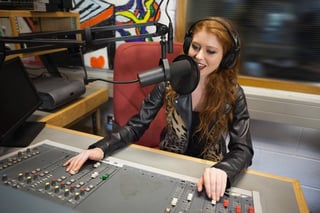Have you ever been in a store or business and you heard employees talking while you think "I wonder what that means?" We tend to get that in radio - more often than you might think. While you're likely familiar with phrases like 'dead air', 'disc jockey', and 'demo', there's a whole list of lingo and buzzwords we use in our industry.
I referenced notes I have from many conferences and industry events, as well as Radio Direct, to compile a complete list of definitions for terms you may hear from time to time in the radio world. We’ll have you sounding like a pro in no time.

Avail: The commercial position in a program or between programs on a given station or network available for purchase by an advertiser. It can also refer to the notification from a buyer to the seller that advertising dollars are up for discussion or negotiation.
Best Time Available (BTA): Commercials which are scheduled by the stations to run at the best available time after all other dayparted commercial advertiser schedules are met, often at night, overnight or during the weekends.
Cluster: A group of stations in the same market, under common ownership or sales management. This usually refers to three or more AM and/or FM stations.
Cost Per Point (CPP): The cost of reaching an audience that is equivalent to one percent of the population in a given demographic group.
Daypart: The time segments into which a day is divided into radio and television networks and stations for the purpose of selling advertising time. In radio, the main dayparts are morning (or AM drive), midday, afternoon (or PM drive), and evening. Advertising contracts should specify the hours that define the time period for each station’s daypart.
Live Read: A specific commercial type where the announcement is read “live” on-air by a station personality.
Local Advertising: Advertising placed by companies within their home area, the limited geographic area where they do business. Also refers to advertising placed by local market agencies scheduled to run in the market where the agency is based.
Opportunity to Hear (OTH): This represents how many times a listener is likely to hear an ad.
Piggy-Back: Two commercials scheduled to run back-to-back, purchased by the same advertiser.
Sponsorship: The purchase of more than one commercial within a program, usually at a premium rate, or the purchase of advertising adjacent to a specific programming feature. Can include bonus time via audio billboards, or exclusivity of advertising within the brand’s product category, or all of the above. It may also refer to the purchase of all or part of a radio program by one advertiser.
Tags: These are like keywords or categories that you can use to classify your music, podcasts, or advertisements. They’re an efficient way of organizing your media library. You can associate as many tags as you want with your songs, podcasts, or advertisements.
Voice Track: Pre-recorded voice clips that produce the illusion of a live DJ sitting in the radio studios when one is not actually present. This is usually used in between songs, to introduce the song title or artist.
I hope this list helps you feel a bit more educated on the terms we can sometimes throw around without thinking. The world or radio - the world I love - is exciting and fast-paced, enjoy!